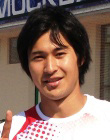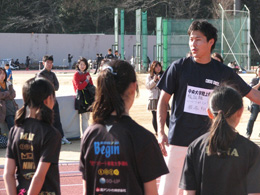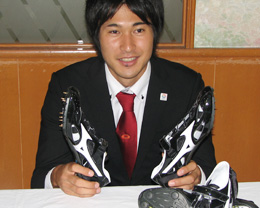Top>People>Life as a top athlete
 Index
Index

Shota Iizuka [profile]
Life as a top athlete
Shota Iizuka
Member of the Chuo University Men’s Track & Field Team (competed in the London Olympics and Moscow World Championships)
The fast sprinter Shota Iizuka (4th-year student in the Faculty of Law) from Chuo University made a strong impression in the men’s 200 meter dash and 400 meter relay at the World Championships held in Moscow in August. Shota also gave a fine performance following last summer’s London Olympics. His training at Chuo University has propelled him to become one of the world’s top athletes.
In the 200 meters, he was one of the only two Japanese athletes to reach the semi-finals. Despite his first time competing in the World Championships, he was able to draw upon his experience at the Olympics.
In the 400 meter relay finals, he once again served as anchor as the Japanese team just as he did at the Olympics. Shota ran on the same track as Usain Bolt (Jamaica), the world’s fastest man. The Japanese team finished in the 6th place, for the first time in two tournaments of the same race. After finishing 5th place at the Olympics, Shota once again made the name Iizuka heard around the world.
“I tried not to be too calm,” says Shota when he describes competing against the world’s best. “I’m not able to run if I think too much about remaining calm. Instead, I try to let my adrenaline flow and run to forget everything. You could say that my mind is completely blank. I can run really well when my mind is completely blank.”
Shota focuses on becoming one of the many spectators cheering from the stands. He does not try to ignore the spectators and enter his own world. Shota found that this mindset has a great effect on his running. At the London Olympics, he faltered under the pressure of the audience’s gaze.
“In some respect, I was satisfied simply to be competing in the Olympics,” he explains. “I felt strange competing on such a stage. It was as if my hunger to compete had disappeared. At the World Championships, I strongly desired to compete and advance to the finals. I also felt more relaxed than at the Olympics. At the World Championships, there were athletes whom I knew from the World Junior Championships and my past experience made me more comfortable competing in a big race.”
The results speak for themselves. At the Olympics, he failed to pass the qualifying rounds for the 200 meters. At the World Championships, he reached the semi-finals in the same event. Shota expressed happiness regarding how he was able to control his emotions when preparing for the race.
“At the World Championships, I felt a great sense of accomplishment upon passing the finish line. Compared to my own feelings, the cheers of 70,000 people seemed hushed.”
Honing his skills

Shota teaches elementary school students at a Chuo University Track & Field Workshop
After the Olympics, Shota left Japan to compete overseas and hone his skills. Based on the Czech Republic, he competed in various tournaments, usually in Europe. His tour of the world in unfamiliar lands was full of happenings and never-ending trouble. “Actually, that’s what I wanted!” says Shota with a smile.
He was forced to rely on public transportation that did not run on time. His participation was suddenly decided the day before a competition. Such things were unthinkable in Japan. Participation in races was determined in order based on the previous best times of runners. For example, if there were 8 spots available and Shota’s previous record was 9th best, he was only able to compete if one of the top runners dropped out.
“I remember one time when I went to watch a big race from the stands, only to be shocked at finding my name on the list of runners!”
Many of the top runners were absent or declined to compete in races. Surrounded by such happenings, Shota was forced to find his own solutions while struggling to deal with the situations. This gave him greater mental strength. His senses became sharper. Shota drew upon this experience at the World Championships and allowed him to give advice to younger runners.
“When competing at the Olympics and other major tournaments, I was often the youngest. However, there are now other runners who are of the same age as me or younger. A popular sprinter, Kiryu is still a high school student! It was a new experience for me.”
Shota handed over lessons from older athletes to Yoshihide Kiryu (Rakunan High School, Kyoto) a 17-year old boy who holds Japan’s second fastest time in the 100 meter dash (10.01 seconds). It was just another passing of the baton from Shota.
“It’s the first time for Kiryu to compete on this scale, so everything is new to him,” says Shota. “So I try to let him know about things in advance, such as warming up before entering a stadium. I told him where to go. I explained that we would be kept waiting before a race, but that it was still possible to move around and use the restroom. I helped him whenever he had a problem. Kiryu is really straightforward and a good kid.”
Transforming knowledge into action

Shota poses in front of his special running spikes. He will be joining the Mizuno Track & Field Team next season.
Shota ran against Bolt in the 200 semi-finals. When asked about Bolt, Shota’s smile vanished and he assumed a serious expression.
“I have great respect for him,” Shota says.
Although taller runners are said to be at a disadvantage in sprints, Bolt uses every inch of his 196-centimeter frame.
“In order to run fast, it’s important to have control over even the smallest muscles in your body,” explains Shota. “Although I’m only 185 centimeters tall, I have great trouble with this. Bolt’s body control is amazing considering his height.”
Shota, who studies anatomy by himself, used an incisive perspective when talking about Bolt.
Shota described how he respects Bolt’s attitude as a champion. Bolt is expected to win every race. True to these expectations, Bolt wows spectators by winning when he runs. After a race, Bolt is surrounded by throngs of fans.
“I want to become that kind of runner,” says Shota when describing Bolt’s attitude of racing to entertain spectators. Shota stresses how he wants to become a runner who can enjoy the pressure of expectations.
It can be said that enjoyment is the source of Shota’s strength. To begin with, Shota enjoys training. He believes that it is impossible to improve without believing in and enjoying training techniques. He knows that uncertainty in training makes it impossible to get stronger. Shota improves by focusing on training to strengthen specific areas of his body, thereby contributing to increased speed. This technique can be described as transforming knowledge into action.
“I don’t believe that good results are the only reason for running a race,” he explains. “I run for myself. I stay loose and enjoy myself.”
Many Japanese athletes will sit down and pray when competing in a major tournament.
“Foreign athletes don’t do that sort of thing,” says Shota. “They’re relaxed and have fun running.”
“Japanese athletes can become stronger if they change their approach to mental preparation.”
Shota’s words carry great weight considering his experience in competing against the world’s best. Will he be able to further hone the attitude of becoming one of the spectators and enjoy running?
The next Olympics will be held in Rio de Janeiro in 2016. “I’m bringing a medal back to Japan,” vows Shota.
Considering Shota’s growing race experience, his mental growth and his age of 25 years old, it seems like the perfect time for him to capture a medal. His next big challenge is the 2015 World Championships in Beijing.
“My goals are to run under 10 seconds in the 100 meters and under 20 seconds in the 200 meters. I won’t settle for anything less than running in the finals.”
Offered by: Hakumon Chuo 2013 Autumn Issue, No. 233
- Shota Iizuka
- Born on June 25th, 1991 in Omaezaki City. After graduating from Fujiedameisei High School, entered the Department of Law in the Faculty of Law, Chuo University. Currently a 4th-year student. Stands 184 centimeters tall and weighs 78 kilograms. Displayed his talent as a runner from an early age, winning the D-class 100 meter dash at the 2004 Junior Olympics when he was in 1st grade of junior high school. Then won the 200 meter dash at the World Junior Championships in July 2010, becoming the first male Japanese runner to win the event. Afterwards, finished 4th in the 100 meter dash and 2nd in the 200 meter dash at the Japan Track & Field Championships held in June 2012. Based on these strong results, selected to compete in two events—the 200 meter dash and 400 meter relay—at the London Olympics. Although he failed to reach the semi-finals for the 200 meter dash when competing in qualifying races at the London Olympics, ran as anchor for the Japanese men’s 4x100 meter relay team which passed qualifiers with a time of 38.07 seconds, 4th best overall. In the finals, the Japanese team ran a time of 38.35 seconds to finish in 5th place overall.
- Research Activities as a Member of Research Fellowship for Young Scientists (DC1), Japan Society for the Promotion of Science (JSPS) Shuma Tsurumi
- Important Factors for Innovation in Payment Services Nobuhiko Sugiura
- Beyond the Concepts of Fellow Citizens and Foreigners— To Achieve SDGs Goal 10 “Reduce Inequality Within and Among Countries” Rika Lee
- Diary of Struggles in Cambodia Fumie Fukuoka
- How Can We Measure Learning Ability?
—Analysis of a Competency Self-Assessment Questionnaire— Yu Saito / Yoko Neha - The Making of the Movie Kirakira Megane








